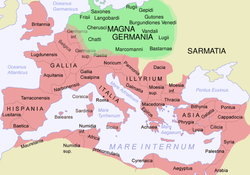- Agri Decumates
-
The agri decumates or decumates agri were a region of the Roman Empire's province of Germania superior ("Upper Germania"), covering the Black Forest area between the Main river and the sources of Danube and Rhine rivers, presently in Southwestern Germany (modern Wurttemberg, Baden and Hohenzollern).[1] To the southeast, the decumates bordered the militarily important province of Raetia. The only ancient reference to the name comes from Tacitus' book Germania.[2]
The meaning of Decumates is lost and has been the subject of much contention. According to the English Classicist Michael Grant, the word probably refers to an ancient Celtic term[3] indicating the political division of the area into "ten cantons."
According to Tacitus, the region had originally been populated by the Celtic tribe of the Helvetii but soon Germanic Suebi[4], possibly under Ariovistus, settled there before migrating, around 9 BCE, to Boiohaemum (modern day Bohemia). After the Suebi left, the area was again inhabited by Gauls. Later on, the region was to become part of the Roman Empire.[5]
Under the Flavian emperors, 69-96 CE, the area was settled and colonized. A network of roads eased legionary communications and improved protection from invading tribes using the re-entrant to penetrate into the Gaulish provinces. Frontier fortifications (limes) were constructed along a line running Rheinbrohl—Arnsburg—Inheiden—Schierenhof—Gunzenhausen—Pförring.
The major places of Roman settlement were Sumolecenna, Civitas Aurelia Aquensis, Lopodunum and Arae Flaviae, modern day Rottenburg am Neckar, Baden-Baden, Ladenburg and Rottweil respectively.
The region flourished during the next two centuries in spite of periods of unrest: around 185/186, a revolt against Roman authority took place, mainly directed against the presence of the Roman military in Argentoratum (modern-day Strasbourg).[citation needed]
The Romans controlled the province until the latter half of the 3rd century, when it was evacuated by the emperor Gallienus (259-260) in the face of invading Alamanni and the secession of much of the Western Roman Empire under the "usurper and ruler" Postumus.[6]
The area may have been briefly reoccupied by the Emperor Aurelian (270-275 CE), during the Roman resurgence of the late 3rd century CE under the so-called "military" emperors. Even if this did occur, the re-establishment of Roman rule was brief. After the death of Emperor Probus (282), the area was finally given up and left to the Alamanni.[7] The territory has since remained inhabited by people of Germanic descent continuously to the present day.[8] However, Roman settlements were not immediately abandoned. There is evidence of continuity of the Roman way life well into the 5th century, much as Roman patterns continued in neighboring Gaul long after the Western Empire's collapse.
J. G. F. Hind[9] has suggested that the inhabitants of the agri decumates are to be found from the later third to the fifth centuries in the decem pagi— also "ten cantons"— transferred west of the Rhine, to the region between that river and the Saar, between Mainz and Metz.
Notes
- ^ M. Grant, A Guide to the Ancient World, p. 17
- ^ M. Grant, A Guide to the Ancient World, p. 17
- ^ J. G. F. Hind, "Whatever Happened to the 'Agri Decumates'?" p. 188, where he links it to the Old Irish dechmad.
- ^ Who would give their name to the present German region of Swabia, covering approximately the same area as the Agri Decumates
- ^ Tacitus, Germania, 29, 3
- ^ L. de Blois, The Policy of the Emperor Gallienus, p. 5, 250
- ^ D. Geuenich, Geschichte der Alemannen, p. 23
- ^ M. Grant, A Guide to the Ancient World, p. 17
- ^ J. G. F. Hind, "Whatever Happened to the 'Agri Decumates'?", p. 189ff.
Bibliography
- Lukas, de Blois (1976), The Policy of the Emperor Gallienus, Leiden: E. J. Brill, ISBN 9-0040-4508-2
- Geuenich, Dieter (1997), Geschichte der Alemannen, Stuttgart: Kohlhammer, ISBN 3-1701-2095-6 (German)
- Grant, Michael (1986), A Guide to the Ancient World: A Dictionary of Classical Place Names, New York: H. W. Wilson, ISBN 0-7607-4134-4
- Hind, J. G. F. (1984), "Whatever Happened to the 'Agri Decumates'?", Britannia 5: 187–192
- Strayer, Joseph R. (1982), Dictionary of the Middle Ages, 1, New York: Scribner, ISBN 0-6841-8276-9
- Jankuhn, Herbert; Beck, Heinrich (eds.) (1984), Reallexikon der germanischen Altertumskunde, 5, Berlin: de Gruyter, ISBN 3-1100-9635-8
- Syme, Ronald (ed.) (1958), Tacitus, 1, Oxford: Clarendon Press
- This article incorporates information from the revision as of February 9, 2006 of the equivalent article on the German Wikipedia.
Categories:- Roman Empire
- History of the Germanic peoples
- Latin words and phrases
- Helvetii
Wikimedia Foundation. 2010.



